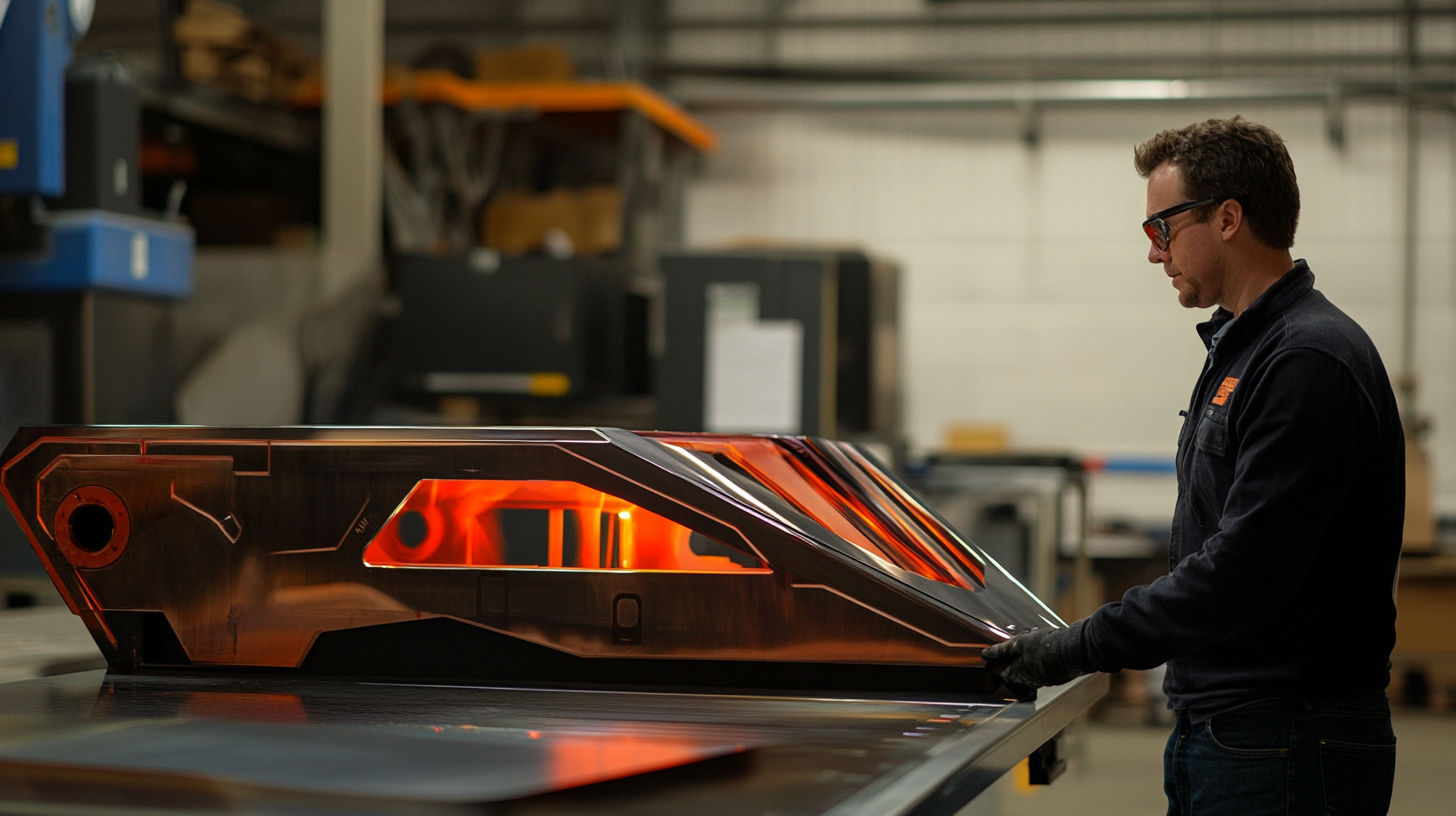© 2025 Messer Cutting Systems, Inc.
In recent years, the manufacturing sector has witnessed a remarkable shift towards automation and precision, with the CNC Laser Cutting Machine emerging as a pivotal technology driving this transformation. According to a report by MarketsandMarkets, the global CNC laser cutting market is projected to reach USD 5.47 billion by 2026, growing at a CAGR of 6.4% from 2021. This growth is fueled by the increasing demand for high-quality cutting solutions that offer efficiency and sustainability. The ability of CNC laser cutting machines to produce intricate designs with minimal waste not only enhances productivity but also reduces operational costs, making it an attractive option for various industries, including automotive, aerospace, and electronics. As organizations continue to seek innovative approaches to optimize their production processes, the integration of CNC laser cutting technology stands at the forefront, promising to reshape the future of manufacturing efficiency.

CNC (Computer Numerical Control) laser cutting technology has revolutionized the manufacturing industry by providing unparalleled precision and efficiency in cutting various materials. According to a report by MarketsandMarkets, the global CNC laser cutting machine market is expected to reach $6.5 billion by 2026, growing at a CAGR of 6.2% from 2021. This growth is largely driven by advancements in laser technology, enabling manufacturers to produce complex designs with minimal material waste.
At the core of CNC laser cutting technology are its fundamental processes, including the selection of laser types (CO2 vs. fiber), power settings, and cutting speeds that are crucial for different materials. For instance, fiber lasers are becoming increasingly popular due to their efficiency in cutting metals like steel and aluminum. A study published in the Journal of Manufacturing Science and Engineering highlights that fiber laser systems can operate at a cutting speed 2-3 times faster than CO2 lasers, making them a preferred choice for businesses aiming to maximize output while reducing operational costs. Consequently, understanding these fundamentals is essential for manufacturers looking to stay competitive in a rapidly evolving landscape.
| Technique | Description | Benefits | Application Areas |
|---|---|---|---|
| High-Speed Laser Cutting | Utilizes advanced optics to increase cutting speed. | Enhanced productivity, reduced operation costs. | Automotive, Aerospace, Electronics. |
| Fiber Laser Technology | Using fiber optics for improved energy conversion and cutting ability. | Superior efficiency, excellent cut quality. | Metal fabrication, Jewelry making. |
| CNC Calibration | Regular adjustment of CNC parameters for optimal performance. | Increased precision, longer machine life. | Manufacturing, Prototyping. |
| Automatic Material Detection | System detects material type and adjusts settings accordingly. | Reduced setup time, minimized errors. | Variety of industries involving different materials. |
| Real-time Monitoring | Continuous oversight of laser performance and cut quality. | Immediate troubleshooting, improved output consistency. | Production lines, Research and Development. |
In the rapidly evolving landscape of manufacturing, CNC laser cutting technology has emerged as a cornerstone for enhancing material precision. Key innovations in this field have transformed not only the methods of cutting but also the overall efficiency of production processes. One significant advancement is the integration of advanced software algorithms that optimize cutting paths, reducing waste and maximizing output. These algorithms offer real-time adjustments based on material properties, leading to more precise cuts and improved edge quality.
Another noteworthy innovation is the introduction of high-speed fiber lasers, which deliver greater energy efficiency and faster operation compared to traditional CO2 lasers. This shift not only accelerates production times but also allows manufacturers to work with a wider range of materials, including metals and plastics, without compromising precision. Moreover, advancements in automation and robotics have enabled seamless integration of laser cutting systems into existing workflows, further enhancing productivity. As these technologies continue to evolve, they pave the way for unprecedented levels of accuracy and efficiency, setting new standards in the industry.
In the realm of CNC laser operations, streamlining workflow is essential for maximizing efficiency and ensuring precision. One innovative approach is the integration of advanced tool crib management systems. By documenting tool requirements and synchronizing tool demand from the computer-aided manufacturing (CAM) process, manufacturers can significantly reduce downtime related to tool management. This not only enhances productivity but also leads to more accurate machining, as operators can easily access the tools they need without delays.
Another effective strategy involves leveraging cutting-edge control solutions that enhance the overall machining process. These controls improve accuracy and facilitate automation, allowing for a seamless transition between different phases of production. By implementing such technologies, companies can minimize errors, optimize machining cycles, and ultimately boost throughput. The combination of robust tool management and precision controls forms a strong foundation for streamlining CNC laser operations, paving the way for innovative efficiencies within the industry.
In the rapidly evolving landscape of manufacturing, integrating automation with CNC laser cutting technology has emerged as a game-changer for maximizing output and efficiency. By incorporating automated systems, businesses can streamline their operations, reduce downtime, and enhance precision in their cutting processes. The synergy between automation and CNC laser cutting not only speeds up production times but also minimizes human error, allowing operators to focus on more strategic tasks rather than routine operations.
Moreover, the advancements in CNC technology have empowered manufacturers to adapt to various applications across industries. For instance, in the medical technology sector, the ability to perform intricate cuts with high precision can significantly enhance the fabrication of medical devices. As manufacturers embrace these innovative approaches, they benefit from increased productivity and cost efficiency while meeting stringent quality standards.
The surge in automation within CNC laser cutting aligns with the growing demand for advanced fabrication methods. Organizations that leverage these innovations will not only improve their manufacturing capabilities but also gain a competitive edge in today's fast-paced market. The future of manufacturing lies in the seamless integration of automation, and CNC laser cutting technology stands at the forefront of this transformation.

Laser cutting technology has been rapidly evolving, with several advancements driving the industry toward unprecedented efficiency and precision. One significant trend is the integration of artificial intelligence and machine learning into CNC laser systems. These technologies enable real-time monitoring and adjustments during the cutting process, allowing for optimized cutting paths and reduced material waste. The ability to analyze data and predict maintenance needs will undoubtedly prolong equipment lifespan and minimize downtime, ensuring a smoother operation.
Another advancement reshaping the laser cutting landscape is the development of fiber laser technology. Compared to traditional CO2 lasers, fiber lasers provide higher energy efficiency and greater cutting speeds, particularly for metals. As industries demand more adaptability, fiber lasers offer the versatility needed to handle a variety of materials with minimal setup time. Additionally, advancements in automation, such as robotic integration, are streamlining workflows, enhancing productivity, and allowing businesses to meet growing market demands for precision and speed without compromising quality.

© 2025 Messer Cutting Systems, Inc.